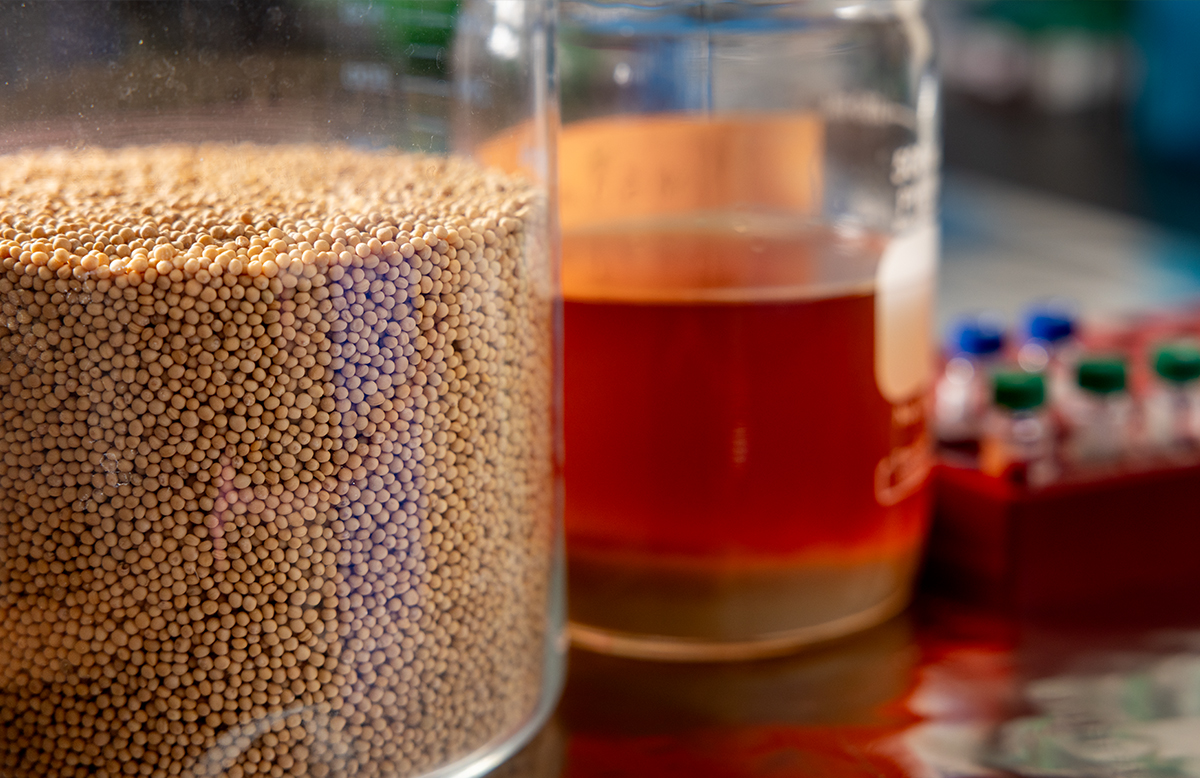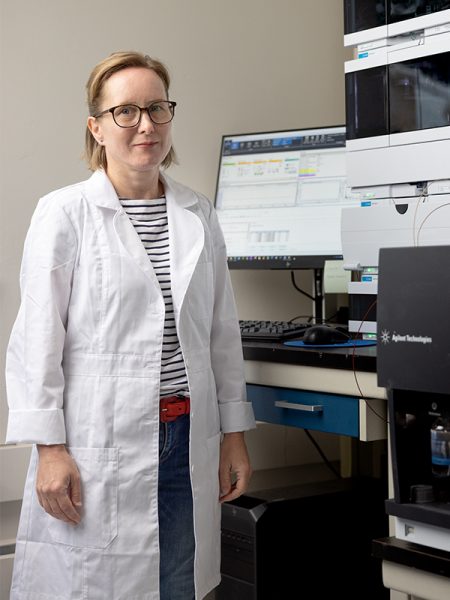Living Science
The Hunt for Biopesticides and Decontaminants that Cut the Mustard
Inna Popova is exploring the inherent powers of plants, such as mustard, to create new, safer ways to defeat pests. She's also studying the natural ability of burnt biomass to clean contaminated soil.

Inna Popova is a chemist who came to love soil. During her training in analytical and physical chemistry, she found herself increasingly drawn to questions about soil contamination and health. When she joined the Department of Soil and Environmental Sciences as an assistant professor in 2022, she found a community of like-minded colleagues. They have since become her invaluable collaborators, partners on chemical studies that look for ways to protect, sustain, and improve the soil and ensure healthy fields in the future.
Popova’s research program looks at both sides of the sustainability coin. On one side, she wants to learn how to prevent contamination of the soil by using biopesticides instead of synthetic chemicals. On the other, she hopes to uncover methods for using biochar to remove contamination already in the soil. The motivation tying all of her work together? Practicality. She wants the solutions her research might yield to be affordable, accessible, and applicable for producers and homeowners.
What are biopesticides?
Plants rely on survival, and their survival is really limited. They cannot run away from danger, so they have to preserve themselves by producing chemicals that would make them immune to pests, to attacks. So, the idea is that if plants have those chemicals, then instead of synthesizing something in the lab, why can’t we just see what is in the plant? Plants have already designed those chemicals, so these are sophisticated systems. The whole idea is to use what is already created by nature to our advantage.
Also, many plant-derived chemicals that can be used as pesticides have better properties in terms of biodegradability, so they might be less toxic. Often, they can be renewably produced, so if you have a plant that can be grown with relatively low inputs, you can have a more sustainable system.

You’ve published some studies on mustard plants. Why is mustard a good candidate for biopesticide?
First, I want to say that it’s not my idea. There is a lot of cultural and historical knowledge about mustard keeping pests away. People may not know why, but they use it because it works. And we as scientists come and ask why it works.
Mustard is an industrial crop, and for the biopesticide we’re using a part of the plant that is considered a waste from the oil production. We’re taking that waste and converting it into a product to maybe make it more profitable. And although we don’t really grow a lot of mustard in the Midwest, we have different crops that can be grown here, like pennycress, that have similar chemistry. So, the research we do on one crop can be transferable to a different crop.
By producing this biopesticide, we could create new opportunities for growers to make a little bit of income from what they now must pay to dispose. When we look at these biopesticides, we want to know if it can be profitable. Can it actually help our producers? I want to see it being applied.
What kind of pests is the mustard by-product protecting against?
They work on a range of plants, pests, and insects. We look at weeds, wireworms, and potato nematodes. We’re starting to look at whether biopesticides could control ticks. Ticks can be a really big problem for livestock in Wisconsin. For example, if you’re involved in organic beef production and you are in an area with high tick density, you’re really limited on the options for what you can use for pest control. So, biopesticides would be useful not only in crops but also in animal systems.
What other systems are you looking at for biopesticide use?
We’re also looking at potatoes through a U.S. Department of Agriculture project called Potatoes and Pests — Actionable Science Against Nematodes, or, for short, PAPAS, the Latin word for potatoes. The goal is to develop tools to control potato nematodes. For our part, we are trying to see if we can design some biopesticides. Many of the pesticides that are currently used are toxic and being phased out.
We’re looking at mustard as well as a very interesting crop, Litchi tomato. Litchi tomatoes are a wild relative of potatoes, and they are resistant to nematodes, so there is some chemical in the plant that kills the pests. When we domesticate plants for food quality and yields, we often lose some of the plant defense chemicals as a trade-off. But if we go back to the wild plant and find it, we could use it.
What about soils that are already contaminated?
With biopesticides, we’re essentially trying to prevent contaminants from going into the soil. But if we’re at the stage where we already have unwanted things in the soil, how do we deal with that?
Here in Wisconsin, we have the Central Sands, a large area with low organic carbon. With sandy soils, you can have many chemicals going into the groundwater, which is a concern for people who get their water from wells. We are looking at PFAS in these sandier soils. Because even if there are some data for PFAS fate (its behavior in the environment after being released) in soil from different states, they’re not all going to have sandy soil, and they’re not all going to have shallow aquifers. We’re trying to address it at the state level and see what we can do. If you change the pH, use more fertilizer, what does it mean for the contaminants? Do they become more mobile and move into groundwater, or do they stick harder?
What Is PFAS?
PFAS, which stands for per- or polyfluoroalkyl substances, are widely used, human-made chemicals that can be harmful to people and animals. They do not break down easily, and their persistence in the environment and in living bodies has earned them the nickname “forever chemicals.”
How do you think biochar can help?
Biochar is essentially burned biomass that is lightweight and porous and has been shown to absorb pollutants from an environment. As we come across more and different contaminants, we’re looking at using the biochars to see if they can bind up the contaminants and get them out of the system.
There are different ways to get biochar. You can create it yourself by pyrolyzing different materials — wood chips or grass — at specific temperatures. You can also buy commercial biochar. We’re comparing these to see which might work better, what the trade-offs are. Maybe for some chemicals, you can only use something designed; and if they’re especially toxic, that may justify the cost and effort. Maybe with other contaminants, you can use a more generic biochar and remove, say, 60% of the contamination, and that’s good enough for safety.
What types of contamination are you looking to remove from soil?
We have several students working on different contaminants. As I mentioned, PFAS is one that is always of interest, and we are also looking at pesticides, namely neonicotinoids, a common class of insecticides known to affect pollinators. Another interesting project came from a student who wanted to look into concerns of contamination at the Badger Ammunition Plant in Baraboo, Wisconsin. She wants to study the interaction of biochars on the industrial chemicals in that area.
What we really want to know is if biochar can work for many things. And does it have to be custom-made? To make it practical, we have to understand the fundamental principles. We’re building the blocks, and maybe a biological engineer or someone else can design something with the knowledge we’re gathering.
This article was posted in Bioenergy and Bioproducts, Fall 2025, Healthy Ecosystems, Living Science and tagged biochar, biopesticides, Inna Popova, mustard, PFAS, soil and Environmental Sciences, sustainability.
